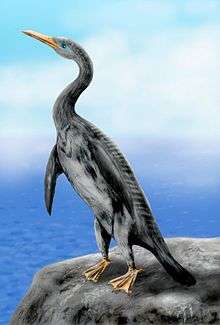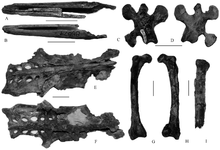Plotopteridae
| Plotopterids Temporal range: Eocene – Miocene | |
|---|---|
 | |
| Copepteryx | |
| Scientific classification | |
| Kingdom: | Animalia |
| Phylum: | Chordata |
| Class: | Aves |
| Order: | Suliformes |
| Family: | Plotopteridae Howard, 1969 |
| Genera | |
|
Copepteryx | |
Plotopteridae is the name of an extinct family of flightless seabirds from the order Suliformes. Related to the gannets and boobies, they exhibited remarkable convergent evolution with the penguins, particularly with the now extinct giant penguins. That they lived in the North Pacific, the other side of the world from the penguins, has led to them being described at times as the Northern Hemisphere's penguins, though they were not closely related. More recent studies have shown, however, that the shoulder-girdle, forelimb and sternum of plotopterids differ significantly from those of penguins, so comparisons in terms of function may not be entirely accurate.[1]
Their fossils have been found in California, Washington, British Columbia and Japan. They ranged in size from that of a large cormorant (such as a Brandt's cormorant), to being 2 m long. They had shortened wings designed for underwater wing-propelled pursuit diving (like penguins or the now extinct great auk), a body skeleton similar to that of the darter and the skull similar to that of a sulid.

The earliest known Plotopteridae species, Phocavis maritimus lived in the mid-Eocene, but most of the known species lived in the early and mid-Miocene, after which it appears they became extinct. That they became extinct at the same time as the giant penguins of the Southern Hemisphere, which also coincided with the radiation of the seals and dolphins, has led to speculation that the expansion of marine mammals was responsible for the extinction of the Plotopteridae, though this has not been formally tested.
References
- ↑ Tatsuro et al, New Skeletal Remains of Plotopterids from Japan, SVP 2015
- Howard, H. (1969). "A new avian fossil from Kern County, California" (PDF). Condor. 71: 68–69. doi:10.2307/1366050.
- Olson, Storrs L.; Hasegawa, Yoshikazu; Hasegawa (1979). "Fossil Counterparts of Giant Penguins from the North Pacific". Science. 206 (4419): 688–689. Bibcode:1979Sci...206..688O. doi:10.1126/science.206.4419.688.
- Olson, Storrs L. & Hasegawa, Yoshikazu (1996). "A new genus and two new species of gigantic Plotopteridae from Japan (Aves: Pelecaniformes)". J. Vert. Paleontol. 16 (4): 742–751. doi:10.1080/02724634.1996.10011362.
- Schreiber, E.A. & Burger, J. (2001). Biology of Marine Birds. ISBN 0-8493-9882-7.
- Mayr, Gerald (2005). "Tertiary plotopterids (Aves, Plotopteridae) and a novel hypothesis on the phylogenetic relationships of penguins (Spheniscidae)" (PDF). Journal of Zoological Systematics. 43 (1): 67–71. doi:10.1111/j.1439-0469.2004.00291.x.
- Gary Kaiser, Junya Watanabe & Marji Johns (2015). "A new member of the family Plotopteridae (Aves) from the late Oligocene of British Columbia, Canada". Palaeontologia Electronica. 18 (3): Article number 18.3.52A.
- Gerald Mayr & James L. Goedert (2016). "New late Eocene and Oligocene remains of the flightless, penguin-like plotopterids (Aves, Plotopteridae) from western Washington State, U.S.A.". Journal of Vertebrate Paleontology. 36 (4): e1163573. doi:10.1080/02724634.2016.1163573.